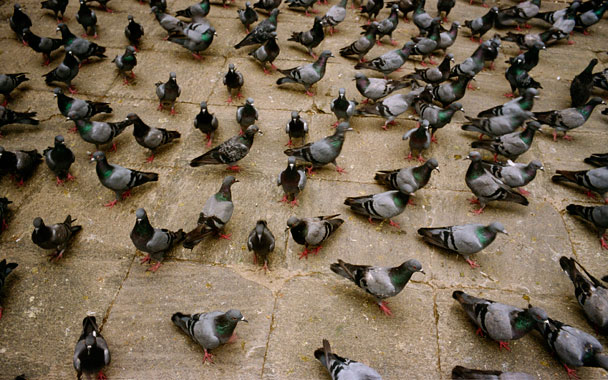If any bird has an image problem, it’s the pigeon. Known as dirty, pesky, trash-picking urbanites—“rats with wings,” if you’re feeling less charitable—these ubiquitous birds can somehow live in our streets and still retain their reputation as gastronomic delicacies.
There’s a reason for that: Pigeons taste great.
They are typically eaten at about four weeks of age, just before they leave the nest. These young pigeons, called squabs, have dark, tender meat full of rich, gamey flavor. But make no mistake: Though they are bred and raised on specialty farms, they’re the same species as the pigeons on the street, the Rock Pigeon.
It’s difficult to find squab in grocery stores, and the price of the bird at restaurants is on par with lobster. My first experience eating squab was at Boston’s No. 9 Park, which happens to be located across the street from Boston Common, where throngs of street pigeons gather every day to beg for bagel scraps and day-old bread. Any qualms I had about this irony vanished when I had my first taste. Served on a bed of purple rice with wild mushrooms, the deep red meat was earthy and flavorful, and I instantly understood why the bird has long been considered a delicacy.
But if pigeons are so tasty, why shouldn’t we all start feasting on the ones that fill our streets (and do our part for pigeon control)? Some Europeans did just that during the lean years of World War II, but under normal circumstances few people are tempted by city birds, and with good reason. Milt Friend, a wildlife expert from the National Wildlife Health Center, says that city pigeons are notorious for having large amounts of lead in their bodies. They accumulate lead not only by breathing polluted air, but also by ingesting everything from paint chips to roadside dust, which also includes such nasty stuff as cadmium particles from vehicle tires. (For this reason, the birds have been used to study environmental contaminants in cities.) While pigeons living in rural areas are fair game, Friend says, “I’d have to be awful hungry to eat a pigeon off the street.”
It’s worth noting, though, that the street pigeons we see in North America today are here because pigeons were carried over on ships to feed European colonists. In fact, people have been feasting on these birds for thousands of years.
Ancient Egyptian and Biblical texts attest that pigeons were eaten and offered as religious sacrifices. And pigeons were a favored bird of the Romans, who loved poultry of all kinds, developing ruthless ways to keep the birds fat and tender that included breaking their legs.
In Europe in the Middle Ages, pigeons were kept in lofts at the tops of houses or in large stone dovecotes, which became a hallmark of every country estate. (Doves, by the way, are closely related to pigeons, but they’re not the same species.) Pigeon-keeping was often a luxury of the nobility, particularly in France, where the birds of wealthy landowners were allowed to feed on the commoners’ fields.
In the U.S., pigeons were also kept on estates and farms, but some entrepreneurial pigeon-breeders tried to launch large-scale pigeon farms beginning in the early 1900s. They raised large breeds with names like Silver King, Carneau, and Swiss Mondaine. Manuals were published that boasted of the profits to be found in pigeons, but many of these ventures went bust before long. In the end, as agriculture industrialized, squab couldn’t compete with chicken, which offers much more meat—indeed, a bucket of fried squab probably wouldn’t look very satisfying at a drive-through window. But that’s not the only reason squab hasn’t taken off.
Squabs require a lot of parenting. Pigeons are altricial, meaning that chicks live in the nest for up to a month before ever venturing out on their own. Chickens, on the other hand, are precocial birds—when chicks hatch they’re ready to walk around and find their own food—which makes keeping chickens far more efficient. Also, chickens can lay more than 200 eggs a year, while pigeons can raise only a dozen or so squabs.
Today, a few pigeon farms in the U.S. still sell squab commercially to restaurants and specialty grocery stores. Tony Barwick heads the largest pigeon farm in the country, the Palmetto Pigeon Plant in South Carolina, which produces over 400,000 squabs every year. Barwick says squab was “immensely popular” in the 1800s and early 1900s because American society was largely agrarian and pigeons were easy to keep on farms. But as people moved into cities they left behind their squab-eating ways. Now the squab business is on the rise again, with Asian markets, particularly restaurants in Chinatowns, composing the largest slice of Palmetto’s business. Demand for squab also comes from what Barwick calls the “white-tablecloth” market of upscale restaurants, and natural-foods suppliers like Whole Foods (Barwick says his farm has always emphasized all-natural, antibiotic-free birds).
Squab is still eaten around the world, where it figures in several traditional dishes. In Europe, pigeon pie was once a popular meal, but in modern dishes squab is usually served roasted on the bone. In Chinese cooking, the birds are often glazed and deep fried, and served complete with the head. In the Moroccan dish b’stilla (sometimes bastilla or pastilla), pigeon meat is cooked into pastry crust topped with sugar, cinnamon, and almonds. And pigeon is still popular in Egypt, where it is often served grilled or roasted and stuffed.
You may not salivate when you see pigeons in a park battling over a stale inch of pizza crust, but given the bird’s enduring reputation--as well as the continuing globalization of the American palate--there’s little doubt these dishes will continue to appear on restaurant menus, no matter how unpopular our street pigeons become.

